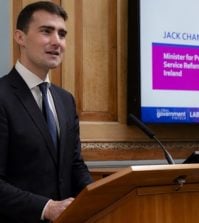Martti Hetemäki, Ministry of Finance, Finland: Exclusive Interview

The 2008 global financial crash hit Finland harder than many other European countries. Head of the Finnish Ministry of Finance Martti Hetemäki tells Global Government Forum in an exclusive interview why Finland suffered so badly and what needs to be done to get the country’s economy back on track
In 1991 a severe recession plaguing western Europe started to hit Finland. In what later became known as the ‘Nordic crisis’ from 1991-93, Finland saw its unemployment rate rise from 3% to around 18% and its GDP contracted for several consecutive years.
Amidst this turmoil, Martti Hetemäki received his first promotion to the senior civil service in Finland’s Ministry of Finance. In his mid-30s at the time, he could look back on almost 10 years’ experience in the department, which he joined fresh out of university in 1983. But, hardly anything could have prepared him for what he faced on his first day as senior secretary in 1991: the most severe peacetime crisis in the 20th century in Finland.
Dealing with a crisis
Was he thrown in at the deep end? “No, we were just in the middle of a very difficult situation as I took my position as a senior civil servant,” he says. He learnt quickly, and helped devise policies, which helped Finland recover from the crash “fairly rapidly”, he says.
The bulk of these measures, he explains, were aimed at boosting Finland’s competitiveness: “There was a lot of emphasis on research, development and education. And the government was also able to support wage moderation by reducing taxes on labour, meaning it gave people a real term increase to their salaries. But, at the same time there were expenditure cuts, which outweighed the tax cuts.”
Eventually, “the economy recovered, there was economic growth, unemployment fell, which, of course, improved public finances.” The recovery took about five years, Hetemäki says.
He counts these policies among his biggest achievements during his 20 years as a senior civil servant. Another major achievement, he says, has been the work done by a group he led on tax reform in 2010. When he worked in his previous post as under secretary of the finance ministry, Hetemäki chaired a tax working group which had “many of its proposals adopted by the government.”
Why were the proposals so important? They helped move the tax system “into a more sustainable direction,” he says. Among changes to corporate income, excise and real estate taxes, was one tax levy that was aimed at not only raising tax revenue but also changing behaviours: a levy on sweets and soft drinks. “We tried to reduce sugar consumption and the policy certainly affected the amount of sweets people consumed.”

Martti Hetemäki, addressing the Global Government Finance Summit in Singapore in April 2015.
How things have changed
Besides seeing a whole population change its behaviour, Hetemäki has also seen how government itself and the role of civil servants has changed over the years. As one of the longest-serving members of the ministry, he can look back on more than 30 years: Hetemäki joined the ministry in 1983 “by coincidence” to do a summer job, which he got because he knew a certain computer programme, he explains. After that, he ended up staying and slowly worked his way up in the ministry. “I always enjoyed that I got to do lots of different things and it was also very international and policy-oriented – overall a great experience,” he says. “The scope of finance ministries is typically very broad.”
Over all this time, he says the ministry and government as a workplace have become more hectic, and civil servants today have to be more flexible, and creative, than when he first joined.
Back then, he says, “functions used to be more straight-forward”, whereas today, “you need to be proactive, take into account your own professional tasks but also what happens in related areas and be much more aware of what happens in the other ministries, as well as other countries.”
Of course, he says, Finland has never existed in the world by itself, “but the global economic environment was not as clearly affecting everything we did.” In order to make Finland a competitive place in the world today, “you need to be aware of what the global economic environment requires and you need to be ready to adjust, because we are a small country that needs to adapt to the world and not the other way around.”
Working together across boundaries
Cross-boundary collaboration was also the focus of a recent study carried out by the Organisation for Economic Co-operation and Development (OECD). The Public Governance Review of Finland and Estonia – the first joint review the OECD has ever undertaken – said that both countries should strengthen a “whole-of-government strategy” and approach by “institutionalizing coordination mechanisms and enhancing cross-ministry coordination.”
This recommendation was “the most important one” in the review, Hetemäki says, as it tackled the question of how to “avoid the problems that often occur with governments when the ministries and organisations are working in silos.”
The review also called on Finland to resolve some “digital governance challenges” and encouraged the two countries to work together on achieving improvements. The Finnish government is currently working through getting the review’s recommendations implemented and, Hetemäki explains, Estonia and Finland have a long history of working together. “They’re our next door neighbours, so clearly we have close contact.”
On the digital front, the two nations have been working together for around two years, and, having borrowed some ideas from Estonia, something big is under way in Finland: the government is building a “national service platform for private and public services – something they have in Estonia already,” he says.
This platform – a €120m programme owned by the finance ministry – is expected to go live in the autumn and will bring together a range of public services, such as filing tax returns, as well as services delivered by private companies, such as banking. Citizens will be able to log in with their credentials just once to enter the platform, “using the same secure identification”.

Martti Hetemäki, speaking to Iain Rennie, State Services Commissioner, New Zealand, at the Global Government Finance Summit in April 2015.
Reviving the Finnish economy
ICT and further digitisation is “absolutely key”, Hetemäki explains, in order to revive the Finnish economy, which contracted for the third year in a row in 2014. Output has yet to return to its level of 2008, before the world financial crisis, underlining the country’s poor performance compared to other euro zone or Nordic nations.
The global financial crisis has been a “good sort of example of how vulnerable we are”, Hetemäki says. Why was Finland hit so much harder than other countries? It faced three major problems: the decline of Nokia, the mobile phone company that contributed about a quarter of Finland’s economic growth between 1998 and 2007; Finland’s pulp and paper industry: “Finland has always been a big exporter of paper,” Hetemäki explains, but with people increasingly “reading things on iPads rather than print-outs, less and less paper is being consumed.”In the six years up to 2012, Finland’s manufacturing sector lost 76,000 jobs – a big number for a nation of only 5.4m.
A third factor has been the accelerating economic weakness of Russia – Finland’s large trading partner – driven by falling oil prices and the tumbling Ruble. “In 2009, we had a major recession in terms of economic growth, GDP fell by over 8% – it was one of the biggest falls in GDP among the EU countries,” he says. And in October 2014, Finland lost its triple-A credit rating from Standard & Poor’s, one of the rating agencies.
Is Finland the ‘sick man of Europe’?
The problems have been deemed so grave by the Financial Times newspaper, that it last year predicted Finland to be the “sick man of Europe” in 2015. But, Hetemäki, who disagrees with the FT’s characterisation, is optimistic about the future. Nokia, he says, “has turned a corner by moving from mobile phones to ICT infrastructure” and the company also took over French telecoms equipment group Alcatel-Lucent in a €15.6bn deal aimed at creating a Finnish-French rival to Ericsson and Huawei in the telecoms equipment industry.
To deal with the demise of the paper industry, Finland has to achieve a “shift from old to new industries”, which the government can support by increasing labour market flexibility – “so that people can move from old jobs to new jobs” and offer more education for free so that “people can upgrade their skills.”
And to counter-act the Russian problem, Finland needs to “find markets somewhere else”. While he admits that finding alternative export partners will not be easy and “is not going to happen over night”, he is hopeful: “We have done it before. In the early nineties the Soviet Union collapsed and back then, our dependency on the trade with it was also quite high, so there were a lot of bankruptcies of firms, but we managed to recover.” For this year, he forecasts “a very modest growth of 0.5%”.
Another big challenge, he says, is handling an ageing population. “That’s a big burden for the public economy,” he says. To address the problem, a working group headed by Hetemäki’s colleague worked up a plan to reform pensions, and in September 2014, the employee and employer organization reached an agreement : from 2017, “the retirement age will be increased and the retirement age will be linked to life expectancy so that when life expectancy goes up so will the retirement age,” he explains. At what age someone will reach retirement age, will depend on which year they were born in. For example, from 2017, someone born in 1980 will reach retirement age when they are 69 years and eight months old, whereas someone born in 1985 will reach it at the age of 70 years and four months.
Looking ahead
So what is next on the agenda to revive the Finnish economy? “There are many things,” he says. “There has to be more labour market flexibility and work must pay, so we need to make sure that there are the right incentives for people to take up work.” But, he quickly adds that before anything can happen, a new government has to be formed and then put forward a programme.
Since the general election on 19 April, weeks of coalition talks have gone by. Formerly opposition Centre Party leader and millionaire Juha Sipilä, who advocates a wage freeze and spending cuts to regain Finland’s competitiveness, beat pro-EU and pro-NATO prime minister Alexander Stubb after four years in power. The former telecoms executive’s party won 49 seats in the 200-member parliament, while the Eurosceptic Finns party won 38 seats. Stubb’s centre-right National Coalition party won 37 seats with the centre-left Social Democrats picking up 34. Four other parties each took fewer than 9% of the votes for the remaining 42 seats.
“We are extremely busy preparing the new government – there are lots of issues to be prepared for them,” Hetemäki says. On Friday, 8 May, the parliamentary groups of the Centre Party, the Finns and the National Coalition party entered government formation talks led by Sipilä.
Hetemäki clearly has a few ideas of what needs to happen in Finland to rescue it from economic slump. And, given his experience of handling the country’s last big recession in the 1990s, he seems well equipped to tackle the current one. But, he will not be able to do much without strong political leadership. He hopes a new government will be in place by the end of May. But how confident is he that the new administration will agree to implement the measures necessary to revive Finland’s economy? He replies diplomatically: “Given that all the major parties are both realistic and responsible, I expect that the new government will implement measures that are necessary to revive the Finnish economy.”





















